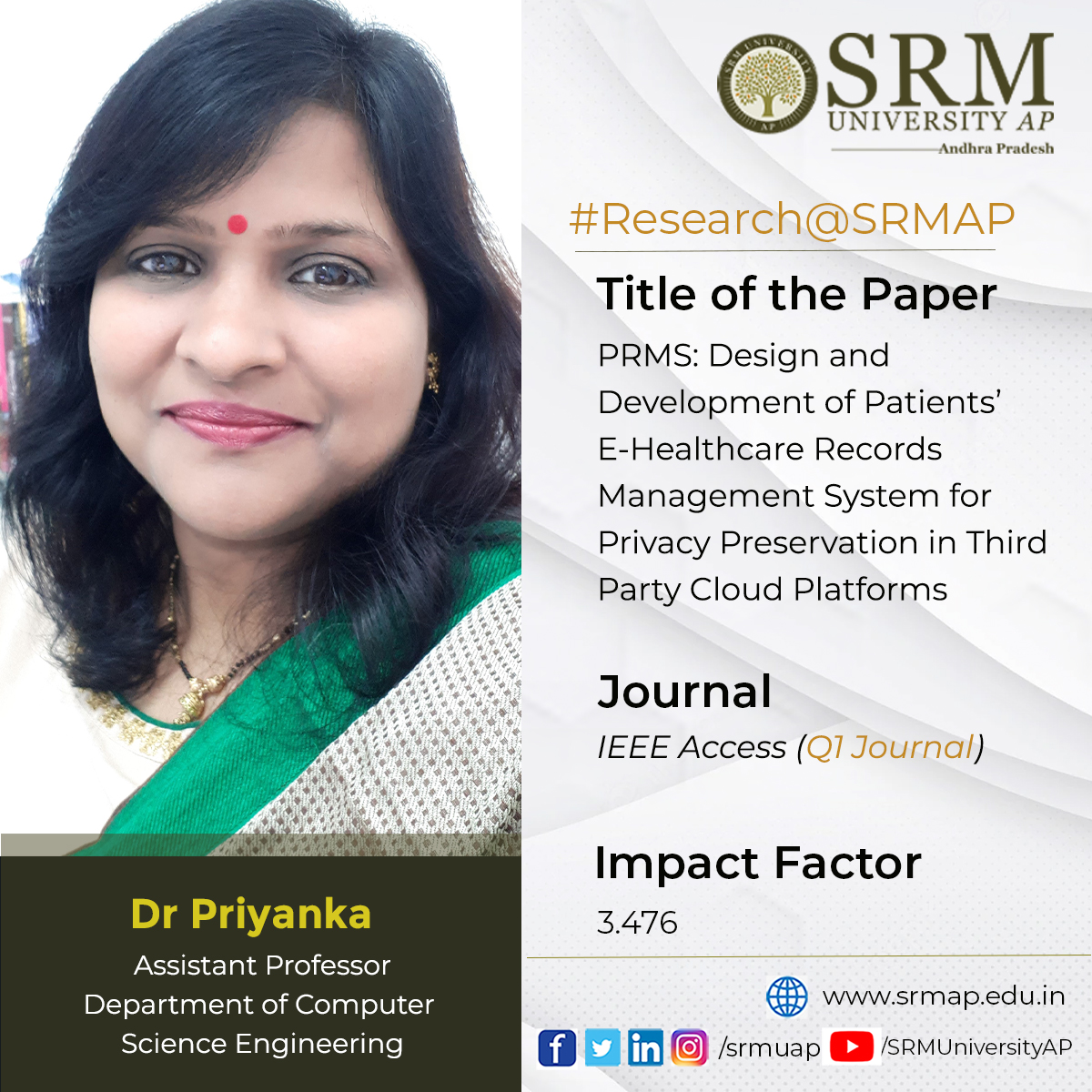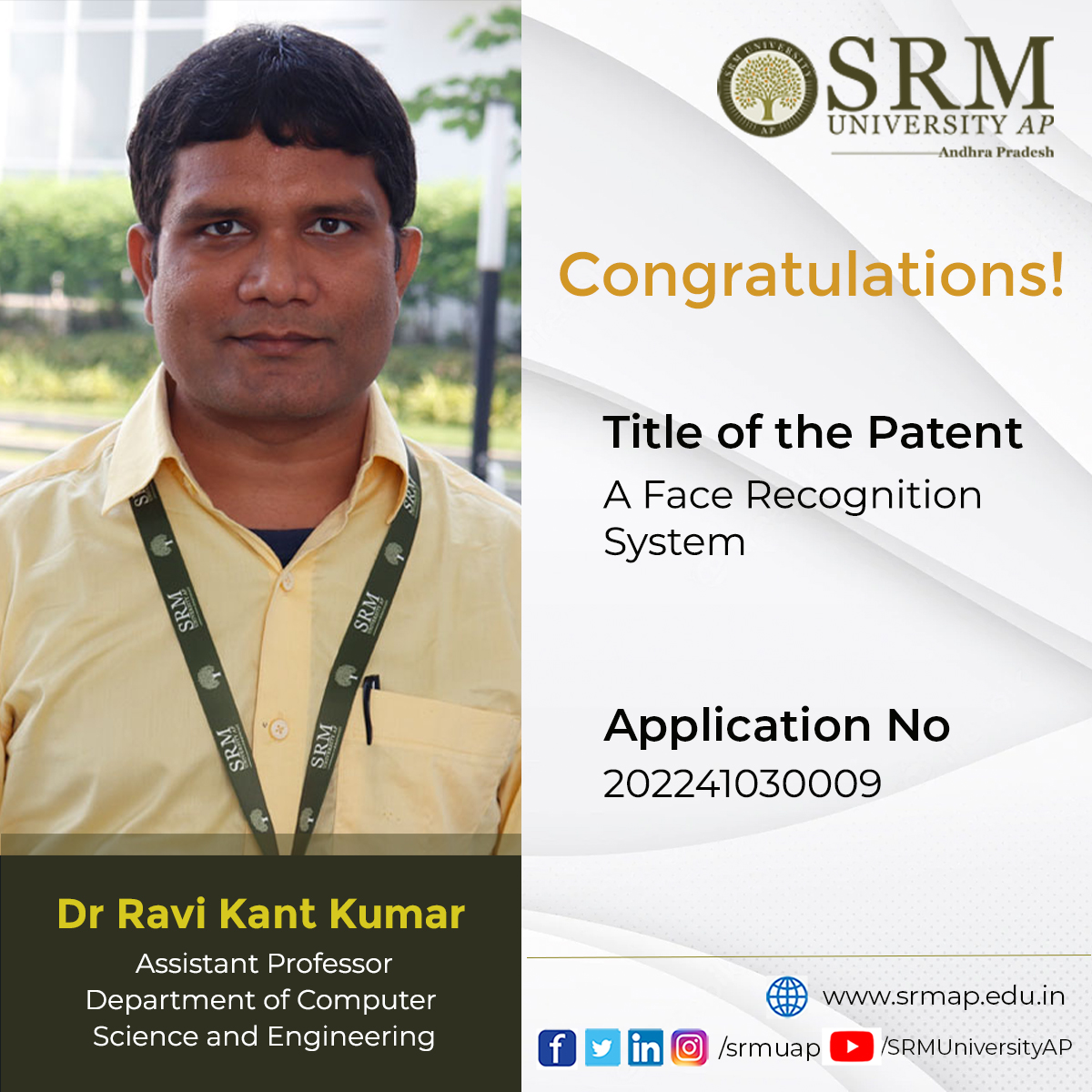Recent News
- Patient’s E Healthcare Records Management System August 23, 2022
 Publishing papers in Q1 journals is a remarkable accomplishment for research enthusiasts. Assistant Professor Dr Priyanka of the Department of Computer Science and Engineering published her latest research paper in the IEEE Access journal. The paper titled PRMS: Design and Development of Patients’ E-Healthcare Records Management System for Privacy Preservation in Third Party Cloud Platforms has an impact factor of 3.476. Kirtirajsinh Zala, Hiren Kumar Thakkar, Rajendrasinh Jadeja, Priyanka Singh, Ketan Kotecha, and Madhu Shukla co-authored the work with Dr Priyanka.
Publishing papers in Q1 journals is a remarkable accomplishment for research enthusiasts. Assistant Professor Dr Priyanka of the Department of Computer Science and Engineering published her latest research paper in the IEEE Access journal. The paper titled PRMS: Design and Development of Patients’ E-Healthcare Records Management System for Privacy Preservation in Third Party Cloud Platforms has an impact factor of 3.476. Kirtirajsinh Zala, Hiren Kumar Thakkar, Rajendrasinh Jadeja, Priyanka Singh, Ketan Kotecha, and Madhu Shukla co-authored the work with Dr Priyanka.Abstract
In the digital era, personal data storage on public platforms is a significant cause of concern with severe security and privacy ramifications. This is true especially in e-health data management since patients’ health data must be managed following a slew of established standards. The Cloud Service Providers (CSPs) primarily provide computing and storage resources. However, data security in the cloud is still a major concern. To overcome e-healthcare records privacy issues in a third-party cloud, we designed a Patient’s E Healthcare Records Management System (PRMS) that focuses on latency and throughput. Moreover, the proposed PRMS system is compared with Blockchain platforms such as Hyperledger Fabric v0.6 and Etherium 1.5.8 against latency and throughput by adjusting the workload for each platform up to 10,000 transactions per second. The proposed PRMS is compared to the Secure and Robust Healthcare Based Blockchain (SRHB) approach using Yahoo Cloud Serving Benchmark (YCSB) and small bank datasets. The experimental results indicate that deploying PRMS on Amazon Web Services decreases System Execution Time (SET) and the Average Delay (AD) time by 2.4%, 8.33%, and 25.15%, 15.26%, respectively. Deploying PRMS on the Google Cloud Platform decreases System Execution Time (SET) and Average Delay (AD) by 2.27%, 2.4%, and 2.72%, 4.73% AD, respectively.
Continue reading → - Facial recognition system August 23, 2022
 Assistant Professor Dr Ravi Kant Kumar of the Department of Computer Science and Engineering aspires to investigate and design the most effective face recognition system appropriate enough to recognise faces in various unconstraint environments. Recently, his patent application titled A Face Recognition System (Application number: 202241030009) got published. He collaborated with his BTech student Thota Venkata Saai Praneeth, for this project. Facial recognition systems have abundant applications in Face Identification, Automobile Security, Access Control, Immigration, Education, Retail, Healthcare, Image database investigations, Surveillance, and many more.
Assistant Professor Dr Ravi Kant Kumar of the Department of Computer Science and Engineering aspires to investigate and design the most effective face recognition system appropriate enough to recognise faces in various unconstraint environments. Recently, his patent application titled A Face Recognition System (Application number: 202241030009) got published. He collaborated with his BTech student Thota Venkata Saai Praneeth, for this project. Facial recognition systems have abundant applications in Face Identification, Automobile Security, Access Control, Immigration, Education, Retail, Healthcare, Image database investigations, Surveillance, and many more.Abstract
A facial recognition system is used for matching a human face captured in an image or a video frame with a database of faces. The system generally authenticates users by measuring facial features from the stored images. The present disclosure relates to face recognition systems. The envisaged system comprises a repository comprising a set of facial images of a plurality of subjects, a set of threshold values, and a plurality of rules. The system further comprises an image capturing unit for capturing a plurality of images of a subject’s face. A segmentation unit divides each image into a plurality of frames. The system further comprises a classifier that receives the frames and classifies frames containing faces from frames containing non-faces from the other frames. The facial features of each frame are extracted by an extractor. An analyser receives the extracted facial features and computes eigenvector values of the facial features of the frame. A comparator compares the computed eigenvector values with threshold values using the comparison rules to identify the subject.
Explanation of the research
Conventional facial recognition systems are configured to identify the contours of a person’s image captured by a camera or in real-time and compare it with the stored image to identify the person. However, external factors such as position, light conditions, camera calibration, and unconstraint conditions, among others, affect the identification of the face of the subject. Hence, comparing the faces with the help of the contours is not reliable. The present disclosure envisages a face recognition system. The system comprises a repository, an image capturing unit, a segmentation unit, a classifier, an extractor, an analyser, and a comparator. The repository consists of a set of facial images of a plurality of subjects, wherein the images define the subject’s facial features in different facial poses. Each image is tagged with an identity, a threshold integral value, and threshold eigenvector values corresponding to the facial features. The repository further comprises a first set of deep learning rules for classifying frames of a captured image into frames containing faces and frames containing non-faces, a set of extraction rules for extracting facial features from the frames 20 containing faces, the second set of deep learning rules for extracting eigenvector values of facial features of the frames containing faces. The repository additionally comprises a set of comparison rules for comparing eigenvector values of the captured facial features with the stored threshold eigenvector values to identify a subject’s face in the captured image.

